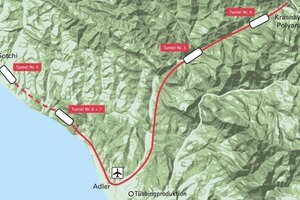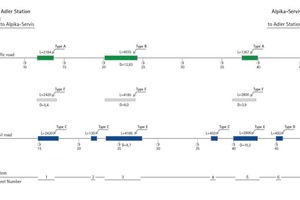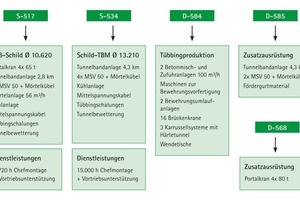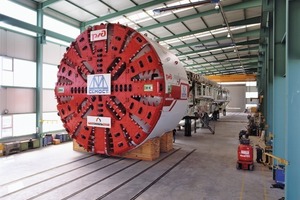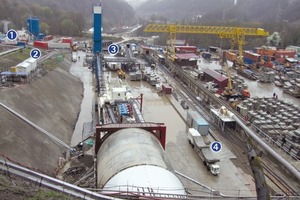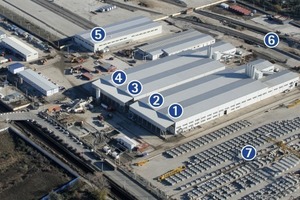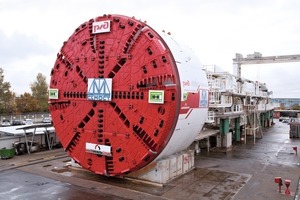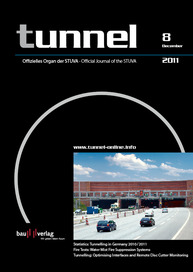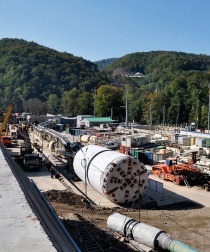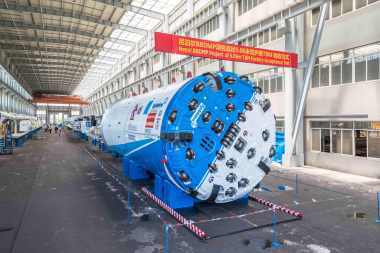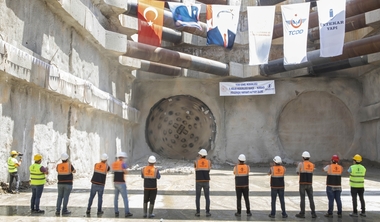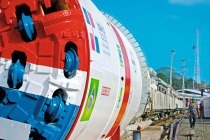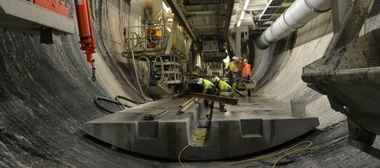Optimising Interfaces for Shield Drives in Sochi
The preparations for the 2014 Winter Olympics are forging ahead in Sochi in Russia. This includes the accomplishing of extensive infrastructural building measures. The following report, which was also presented at the 2011 STUVA Conference in Berlin, looks into the special features associated with the tunnel drives based on an example.
Preparations are in full swing for the 2014 Winter Olympics in Sochi, Russia. Apart from sports facilities and accommodation, an ultra-modern and efficient traffic infrastructure is also being built. In order to develop the area, a railway line and highway combination is being built between the Black Sea coast and the Alpika-Servis ski resort in the Caucasus which represents the core piece of the traffic infrastructure. Along the 48 km route between Adler Airport and the Krasnaya Polyanna ski resort, 6 of a total of 12 tunnels extending more than 20 km are being mechanically driven. In the complex geology, an EPB Shield with a diameter of 10.62 m is being deployed for railway tunnel no. 5 and a single-shield TBM with a diameter of 13.21 m for road tunnel no. 3.
The tight realization schedule for this major project makes high operative demands on the construction companies. To comply with this challenge in an optimum manner, the individual technical equipment and systems involved in and around the tunnel must be perfectly coordinated to achieve the primary goal of high and consistent production output. With its full-range concept, Herrenknecht is moving closer to this goal. Apart from cutting-edge tunnel boring machines, additional equipment and services have also been made available for this major project. Herrenknecht subsidiary H+E Logistik, for example, has supplied 3 tailor-made conveyor plants guaranteeing fast transport of the excavated material. In order to supply the site just in time with segments, Herrenknecht Formwork Technology GmbH has designed and delivered the world‘s largest segment factory. Other site equipment such as gantry cranes, multi-service vehicles, cooling towers and grout mixers as well as service personnel has also been made available. The result is optimized technical and operative interfaces.
1 Project
On the occasion of the 2014 Winter Olympics in Sochi, an efficient traffic infrastructure is currently being built on the Russian side with the aim of creating optimum connections between the various venues. Accordingly, one project involves a road and rail combination extending 21 km between Adler Airport and the Alpika-Servis ski resort as a venue for the downhill competitions near the mountain town of Krasnaya Polyanna (Fig. 1). Owing to the mountainous topology of the Caucasus, this requires various engineering feats, i.e. a total of 12 tunnels excavated by mechanized and conventional tunnelling as well as several bridges. The various transport systems are bundled near the requisite tunnel constructions by two-lane highways and a single-track railway line with a service tunnel arranged in between to ensure supplies to the traffic tunnels. This basic principle was applied for tunnel nos. 1 (tunnel lengths of 2,184 to 2,420 m), 3 (tunnel lengths of 3,169 to 4,565 m) and 5 (tunnel lengths of 1,367 to 2,864 m). On account of the low system-related pitch associated with railways, the railway connection requires three additional shorter tunnels (Fig. 2).
The Russian client‘s original plans envisaged using the Herrenknecht S-517 EPB (10.62 m diameter) for tunnel no. 4 (2 x 4,150 m) along the connection parallel to the Black Sea coast between Rostov on the Donne and the Olympic region of Sochi (Fig. 1). Owing to the tight schedule associated with the Adler-Krasnaya Polyanna connection and to ensure completion of the overall project, a decision was made to use the S-517 Earth Pressure Balance Shield for railway tunnel no. 5 (L = 2,864 m) (Fig. 2). In agreement with the original plans, the S-534 Single Shield TBM (13.21 m diameter) was used for mechanized tunnelling of road tunnel no. 3 (L = 3,169 m).
2 Full-range concept
The tight realization schedule for such a major project and the high operative requirements on the construction companies involved represent particular challenges for a machine supplier, especially when the possible scope of delivery and performance is not limited to a single machine. In our capacity as a full-range provider of mechanized tunnelling services, we took advantage of the opportunity to face the challenges offered by this major project by applying superordinate project management. With the result that a central contact person was available to our Russian client, OAO USK Most and BAMtunnelstroy, as a superordinate client who, in turn, awarded performance and service packages to various Russian construction companies during the course of the project. The lean project organization proved favorable as the project went on in terms of developing tailor-made technical solutions and the enormous logistical effort involved in handling deliveries as well as continuously changing construction partners on the client side as the project progressed. True to the motto of „everything from a single source“, the client was able to benefit from technical and economical advantages by transferring responsibility for the various interfaces to the machine manufacturer. Worth mentioning in this context: this safeguarded the logistics, short delivery times, schedule reliability, flexibility and adaptability to modifications within the project. Apart from the ambitious schedule and logistical targets associated with such a wide-ranging project (handling volume of 32,000 m³; weight: 9,250 t with a total of 276 containers on 7 ships), the full-range concept enables the realization of new technical solutions often only ever possible within the confines of a major project. Fig. 3 provides an overview of the scope of performance and delivery by Herrenknecht for this major project in Sochi.
3 Explanations to individual components
3.1 Tunnel Boring Machines (TBMs)
In order to drive railway tunnel no. 4 with a tunnelling length of 4,150 m, an S-517 Earth Pressure Balance Shield with a shield diameter of 10.62 m was offered and commissioned (Fig. 4a). The machine was designed as an Earth Pressure Balance Shield for tunnelling through layers of loam, sand and grit with an option for more consolidated rock. On account of modifications to the project as a whole, the question arose as to whether the Earth Pressure Balance Shield already in use for driving railway tunnel no. 5 (L = 2,864 m) was suitable. Aspects such as the suitability of the screw conveyor involved in material transport for the EPB Shield were discussed intensively as regards the tunnel length to be driven. The sandstone and marl geology prevalent in railway tunnel no. 5 proved to be suitable for driving the tunnel using an EPB Shield in open mode and machine deployment and additional equipment was swiftly planned anew. The client inquired about an open TBM shield for road tunnel no. 3 (with an original length of 4,035 m and then changed to 3,169 m) in limestone and within the range of > 13 m. On the basis of the components available, a Single Shield TBM was offered with a shield diameter of 13.21 m and an electric drive (3,520 kW) featuring a bearing diameter of 5.6 m (Fig. 4b). The technical data on both TBMs is indicated in Table 1.
3.2 Material transport
Another component of the scope of performance and delivery for material transport by the Herrenknecht Group involved 3 tunnel belt systems from H+E Logistik GmbH. Two conveyor plants with a belt width of 1,000 mm and a capacity of 1,300 t/h were commissioned along with a belt length of 4,320 m (road tunnel no. 3, S-534) and 4,900 m (railway tunnel no. 3, S-517). The drive output was 2 x 355 kW plus a booster station with 90 kW for the upper and lower belts in the tunnel. Another conveyor plant with an 800 mm belt was dimensioned for a capacity of 1,000 t/h and a belt length of 2,850 m (railway tunnel no. 5, S-517). 3 x 160 kW plants were installed, each of which featured a vertical belt storage tower with a storage capacity of 400 m (Fig. 5).
3.3 Segment manufacture
The client, OAO USK Most, planned central segment production on an area spanning 178,149 m² in Vesyolye (Adler District) to ensure segment supplies for all mechanized tunnelling projects (Fig. 6). The size and output of the plant for segment production was designed to supply 4 TBMs simultaneously. The concept envisaged a flexible overall plant which can be segregated into 4 individual plants after completion of segment production for the Sochi project enabling them to be used independently in other tunnel projects. Three fully-automatic segment circulating lines with cranes, handling equipment and heated curing tunnel were delivered for the segment production plant required by the Sochi project (segment supply for road tunnel no. 3 with 11.83 m inner diameter and railway tunnel no. 5 with 9.40 m inner diameter) as well as a hall with equipment for supplying stationary moulds (service tunnel no. 3 with 4.50 to 5.80 m inner diameter).
The scope of supply by Herrenknecht Formwork Technology GmbH also involved additional machinery for reinforcement prefabrication (manufacturing and bending rods, cutting the reinforcing rods to length) and 2 reinforcing basket carousels each with 5 workstations for welding the reinforcing baskets. 2 x 6 sets of moulds (54 and 42 segment moulds) were also supplied for carousel production for tunnel nos. 3 (S-534) and 5 (S-517). The scope of supply was rounded off by concrete mixers, concrete feed and crane systems as well as press frames for installing the segment sealings, vacuum suction plates and turning benches, whereby the entire planning and chief assembly of the turn-key production plants including commissioning was realized from a single source.
April 2009 saw commencement of construction work in the „green belt“. By December 2009, the plant was in full production mode thereby achieving its nominal output a mere 9 months after the contract had been awarded. With a hall area of more than 20,000 m², it is currently the largest segment plant in the world with overall manufacturing capacity comprising 350 segments/day which is equivalent to 90 m of tunnel.
3.4 Additional scope of supply
Further scope of supply involved the guidance systems for the tunnel boring machines (VMT GmbH), 10 multi-service vehicles with a payload of 50 t (Techni Métal Entreprise), grout tanks (10 pieces), separate personnel cabs, segment grabs and suction plates (Maschinen- und Stahlbau Dresden) as well as grout mixers (56 m³/h) for annular gap grout production, cooling tower plants and reaction frames.
4 Project process
4.1 Railway tunnel no. 5
(L = 2,864 m; S-517 EPB Shield; 10.62 m diameter)
January/February 2010 saw commencement of site assembly for the TBM, the conveyor plant and other additional peripheral equipment (grout plant, cooling tower). The requisite reaction frame according to Herrenknecht drawing specifications for driving the TBM was provided locally. Tunnelling commenced April 4, 2010 in a grinding cut necessitating the tunnelling teams to cope with minor sagging by the machine across the first 3 rings as well as gradual collapse. The first few weeks were therefore characterized by the interaction between man, machine and the mountainous terrain as well as the typical learning curve (grout, conditioning) and initial downtimes associated with such a process.
After mastering these initial difficulties and once everyone had understood the requirements of open EPB tunnelling, tunnelling output steadily increased – enabling top performances of 23.4 m/day or 450.6 m/month. During the tunnelling process, both the cutting wheel and screw conveyor were revised. Independent of these results, the TBM achieved an average weekly output of 49 rings/week (or 88 m/week). Tunnelling was completed on breaking through to the target cavern on the other side on February 8-9, 2011. Dismantling of the TBM is planned as of August 2011.
4.2 Road tunnel no. 3
(L = 3,169 m; Single Shield TBM S-534; 13.21 m diameter)
Over the period March through April 2010, the TBM and conveyor plant were assembled on site. A gantry crane with lifting devices of 4 x 80 t was used for dismantling the TBM.
Owing to the prevailing geology, a preliminary cut was planned with crown heading protected by a pipe arch for the first 150 m of tunnel before stable limestone was projected for open mechanized tunnelling. Protected by this pipe arch, the machine was intended to tunnel through the remaining bench and invert excavating the residual cross-section of the tunnel face with the cutterhead and conveyor equipment as partial-face excavation. On account of how the prevailing geology was interpreted and the tight schedule restrictions aimed at maintaining the starting date, this pipe arch was however limited to the first 75 m.
Driving the bench and invert by means of partial-face excavation using a shield TBM did not result in any problems enabling commencement of tunnelling on May 15, 2010. It soon became evident that although specifying a preliminary cut was the right decision, this process had not been performed to the requisite extent. Accordingly, poor stability meant that the geology was not yet suitable for open mechanized tunnelling and collapsing material blocked the cutting wheel. In order to handle this tunnelling situation, injections were performed from above and a pipe arch was drilled out of the machine. Additional smaller auxiliary headings were also performed in parallel by means of cross-passages.
On the technical side, a modification was made to the cutterhead drive gear ratio. By fitting new gears with a reduced transmission ratio (lower speed yet greater transmissible torque), it was possible to improve the situation although the geological problems could not be fundamentally solved. The installation of a five-fold torque would not even have sufficed in such a collapse.
Based on the discoveries made during tunnelling, it is possible to derive the following information in retrospect: with a 100-meter preliminary cut or the use of an Earth Pressure Balance Shield, the difficulties described would have been avoidable. The tight project schedule can be regarded as a reason for the difficulties encountered. In order to handle these difficulties, the familiar geology of the neighbouring mountain along a valley on the section was transferred to tunnel no. 5 without being able to analyze the geology of the actual route to be driven. The respective geology allowed this approach in general but the location and expansion of the collapse zones did not.
Using the experience gained in tunnelling each of the 3 sections in tunnel no. 3 (road, rail and service), 3 additional cross-cuts and tunnels were driven in poor geology for road tunnel no. 5. Necessitated by this geology, the tunnelling route for the road and service tunnel was reduced from 4,200 to 3,169 m and the route altered accordingly.
By mid-July 2011, the machine had meanwhile driven 1,776 m of tunnel. Tunnelling output comprises around 300 m/month. The tunnelling completion date is planned for the turn of the year 2011/2012.
5 Summary
Extensive engineering projects aimed at constructing an efficient road and rail infrastructure in time for the 2014 Winter Olympics are currently underway in Sochi, Russia. One aspect involves the construction of several large-diameter tunnels. The challenges of such a major project demand significant technical tailor-made and logistically demanding solutions – each of which needs to be designed and implemented at a high level. Furthermore, optimization of the large number of interfaces between the components and site processes also plays an outstanding role in terms of high and reliable production output. The full-range concept featuring integrated tunnelling solutions for machine technology, additional equipment and services provides the basis for these conditions. It also includes the responsibility associated with supporting the client during realization and modifications to the project as well as coming up with speedy solutions in all areas. The progress made by this major project to date bears witness to the great willingness by everyone involved to meet the challenges presented and complete the project within the specified timeframe despite all of the difficulties encountered along the way. All in all, the Sochi project is evidence of the fact that well-conceived and coordinated system solutions create a good basis for the construction company when it comes to achieving high tunnelling output rates in mechanized tunnelling processes.

